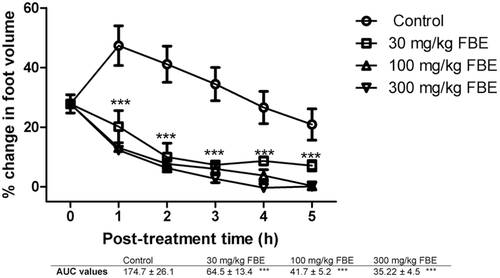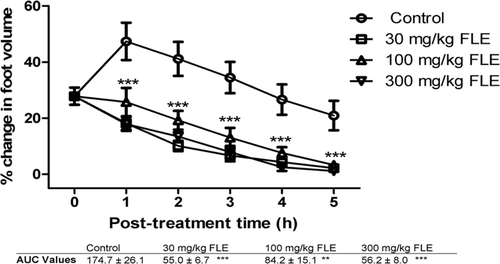Figures & data
Table 1. Preliminary phytochemical screening of ethanol leaf (FLE) and stem bark (FBE) extracts of F. elastica.
Table 2. Antimicrobial activity of ethanol leaf extract (FLE) and ethanol stem bark extract (FBE) of F. elastica by agar diffusion method.
Table 3. Minimum inhibitory concentration (MIC) (mg/mL) of ethanol leaf extract (FLE) and ethanol stem bark extract (FBE) of F. elastica determined by microdilution method.
Figure 1. The effects of 30, 100, and 300 mg/kg of ethanolic stem bark extract (FBE) on carrageenan-induced inflammation in chicks. ***implies p < 0.001 which signifies a significant reduction in foot volume at all dose levels. Data are presented as mean ± SEM (n = 5), analyzed by one-way ANOVA followed by Newman-Keuls test for column graphs. Control is the untreated group.

Figure 2. The effects of 30, 100, and 300 mg/kg of ethanolic leaf extract (FLE) on carrageenan-induced inflammation in chicks. ***implies p < 0.001 which signifies a significant reduction in foot volume at all dose levels. Data are presented as mean ± SEM (n = 5), analyzed by one-way ANOVA followed by Newman-Keuls test for column graphs. Control is the untreated group.

Figure 3. The effects of 0.25, 0.5, and 1.0 mg/kg of dexamethasone on carrageenan-induced inflammation in chicks. ***implies p < 0.001, which signifies a significant reduction in foot volume at all dose levels. Data are presented as mean ± SEM (n = 5), analyzed by one-way ANOVA followed by Newman-Keuls test for column graphs. Control is the untreated group.

Figure 4. The effects of 10, 30, and 100 mg/kg of diclofenac on carrageenan-induced inflammation in chicks. ***implies p < 0.001, which signifies a significant reduction in foot volume at all dose levels. Data are presented as mean ± SEM (n = 5), analyzed by one-way ANOVA followed by Newman-Keuls test for column graphs.Control is the untreated group.

